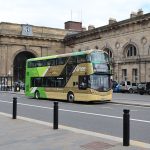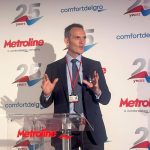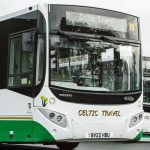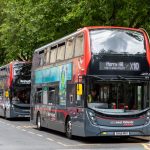Transdev Blazefield is not just talking about creating what in Harrogate it calls the first low-emission bus town in the UK; it is hunkering down and doing it, with copious benefits for residents of the spa town
“We have a dream.” Those are the words of Transdev Blazefield CEO Alex Hornby when he describes plans for its Harrogate Bus Company brand, which will lead ultimately to what Transdev calls the UK’s first low-emission bus town.
The dream started 12 months ago when £3.3m was spent on a fleet of high-specification double-deckers for route 36 to Leeds, and it will continue when some existing buses are upgraded to Euro 6 standards.
But centrepiece is 2018’s arrival of eight full-electric Volvo 7900E single-deckers.
They will utilise charging pylons in Harrogate bus station, and when they enter service, Transdev’s whole fleet used on town services will be Euro 6 or zero-emission.
“This leap forward is a result of a successful £2.2m bid to the government, topped up by a commercial investment of £1.7m by Transdev, in electric buses and charging equipment,” says Mr Hornby.
Whetting appetites
To give stakeholders a taste of what is to come with the 7900Es, Transdev and Volvo showed a similar bus to guests last Thursday (2 February). It is part of the Västtrafik fleet in Gothenburg and uses the same electrical infrastructure as Transdev’s buses will.
The Harrogate buses’ pantograph-based opportunity charging system will come from ABB, and three such stations will be created.
Overnight charging points will also be positioned in Starbeck depot, but there will only four of them. The eight 7900Es will require garage charging only every other day to ‘condition’ their batteries. Most power transfer will be undertaken via the opportunity equipment, meaning that no major infrastructure changes are required at Starbeck.
As ever, Volvo wasted no opportunity to promote electrification, which it regards as the future of urban transport. Ulf Magnusson, Senior Vice-President Europe, attended Thursday’s event and he revealed that of the 3,000 full- or hybrid-electric buses that Volvo has produced so far, half are in service in the UK.
“The UK is a very important market for us. I am delighted that Transdev Blazefield has ordered eight 7900Es,” he says, adding the caveat that in schemes involving electrification, partnership working is vital.
“If the town or city is not involved, it will be a difficult journey. Operators need a good relationship with other parties because electrification is a joint initiative. But with our electric buses, they can do so much.”
Mr Magnusson makes reference to the famous route 55 in Gothenburg, where Volvo’s electric buses drive through a library. “My dream for Harrogate is simple: To help make an electric bus route that runs through Betty’s Tea Room.”
Dream described
Creating a low-emission bus town is the central part of Transdev’s aspirations for Harrogate, but its five-year plan has several other components.
Offering a quality service is among them. Besides upgrading the Volvo B7RLEs used on service 1 to Euro 6, they have been refurbished to a high standard.
They complement the luxurious B5TL double-deckers used on route 36, which have delivered 50,000 additional passenger journeys in the year since their introduction, and a customer satisfaction rating of 97%.
Additionally, 55% of users have access to a car but choose the bus instead. “We are indeed creating buses that people want to be seen on,” says Mr Hornby.
Joining the dots
Integration with other operators, rail services and improving access to Leeds Bradford Airport is also high on Transdev’s agenda, says Mr Hornby.
“We are on a mission to make Harrogate better connected, but we already do the unthinkable by approaching our competitors to set up voluntary partnerships.
“We offer through ticketing to First’s buses in Leeds via a simple add-on to any 36 fare, and we will be doing the same with Arriva’s Yorkshire Tiger subsidiary with one ticket for both operators’ networks to reach Leeds Bradford Airport.”
Perhaps most significantly, Transdev is working with train operating companies Northern and Virgin Trains East Coast to create ‘virtual rail stations’ that are loaded into the national rail fares database.
“That will mean that customers can buy a ticket to parts of our network off the rail network from anywhere in the UK. They will show the ticket to the bus driver and it will be seamless,” says Mr Hornby.
Other things – a yearly Harrogate Bus Day, what he describes as “the best app of its kind” and contactless payment across the town’s network – all form part of the five-year plan to deliver what Transdev predicts will be the UK’s best bus network.
routeone comment
Transdev’s desire to give Harrogate buses of the highest quality is laudable. It is a long-standing effort dating back to 2004, when service 36 was upgraded with what at the time were buses to a ground breaking, industry-shaping specification.
The process will continue for another five years at least, and the eight Volvo 7900E electric buses – the first of their kind for the UK – will form the centrepiece.
Ulf Magnusson of Volvo makes perhaps the most salient point. Such improvements do not come about thanks to the operator alone, he says. Instead, partnership working is imperative, and that is something that should be remembered by local authorities that wish to make a difference to urban air quality.
























